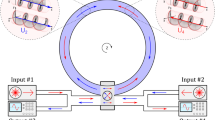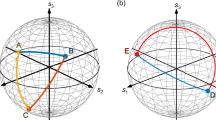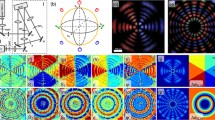Abstract
The co-propagation of double beams in party-time symmetric lattices in the presence of nonlocal nonlinearities has been investigated. An interesting phenomenon has been found that the energy of the beam in the right side has increased almost monotonously, while it oscillates in the absence of nonlinearities. The energy increase can be controlled by adjusting the incident angle of the beam in the left side, since light propagating in party-time symmetric arrays can distinguish left from right. This findings pave the way to all-optical controls in the nonlinear regime.
Similar content being viewed by others
Avoid common mistakes on your manuscript.
1 Introduction
Under the framework of quantum mechanics, the eigenvalues of Hermitian operators are real. In 1998, Bender et al. made a pioneering discovery that non-Hermitian Hamiltonians which satisfied the party-time (PT) symmetry could also have a real eigenvalue spectra [1], which has inspired a lot of research in various physical fields. In 2007, Makris et al. introduced this concept into optics [2], and found the PT symmetric periodic structure exhibited a series of unusual features of beam dynamics associated with the non-orthogonal associated Floquet–Bloch (FB) modes, including birefringence, power oscillation, and the eigenfunction unfolding as well as nonreciprocal diffraction patterns [3]. In 2009, Guo et al. [4] experimentally demonstrated passive PT symmetry breaking with the realm of optics. Later, R\(\ddot{u}\)ter et al. reported the first observation of both spontaneous PT symmetry breaking and power oscillations violating left−right symmetry in a PT optical coupled system [5]. Recently, beam dynamics in disordered PT lattices have also been studied [6].
In nonlinear regime, Musslimani et al. considered the Kerr nonlinearity in PT lattices for the beam propagation can found the formations of 1-D and 2-D solitons [7]. Stable 1-D and 2-D bright spatial solitons in defocusing Kerr media with PT -symmetric potentials have also been found [8]. Dmitriev et al. found that nonlinear PT-symmetric potentials can support stable discrete solitons. Kartashov et al. studied the asymmetric soliton mobility in competing linear-nonlinear PT lattices [10]. He et al. found the solitons in PT-symmetric mixed linear-nonlinear optical lattices.
To the best of our knowledge, the reported works regarding the nonlinear PT lattices or the Kerr nonlinearity plus the linear PT lattices only considered the local nonlinearity. Nonlocal nonlinearity is another aspect in nonlinear optics, which is a very hot topic in the past decade [12,13,14]. Nonlocal nonlinearity has been known as a means of eliminating collapse and stabilizing multidimensional solitary waves [15,16,17], can allow the existences of a rich class of propagation invariant waves [18, 19] and also provide the possibility of long-range interactions of multiple beams [20,21,22]. In this paper, we investigate the long-range interaction of double beams in PT symmetric lattices in the presence of nonlocal nonlinearities in terms of the numerical simulations. The monotonous power increasing of the beam in the right side is observed, of which the physical mechanism is also discussed qualitatively. Due to the beam propagation property in the PT symmetric lattice which can distinguish left from right, we also present an accessible scenario to control the power increasing of the beam in the right side by adjusting the angle of incidence of the left one.
2 Theoretical model and numerical results
The evolution of the double beams in the PT symmetric lattice in the presence of nonlocal nonlinearities is governed by the generalized nonlinear Schrödinger equation which reads [14]:
with \(U(\eta ,\zeta )\) the complex amplitude envelop of the optical beam, \(\eta\) and \(\zeta\) the transverse and longitude coordinates, respectively, \(n_0\) the background refractive index, \(n_R/n_I\) the real index profile/gain or loss distribution of the lattice, \(n_2\) the nonlinear index coefficient. \(R(\eta )\) represents the nonlocal nonlinear response function of the media. By introducing the following scaled quantities, \(z=\zeta /(k_0n_0w_0^2)\), \(x=\eta /w_0\), \(V_{pt}(x)=k_0^2n_0w_0^2(n_R+in_I)\), \(u=\sqrt{n_0n_2}k_0w_0U\) and \(\overline{R}=w_0R\), with \(w_0\) the arbitrary transverse scaling factor, then Eq. (1) can be normalized in the form:
For convenience, we refer to \(w_0\pi\) as the period of \(n_R\), the PT potential is assumed to be,
and \(A_p\) is chosen to be 4 (The estimation of the parameters from a physical perspective can be found in Ref. [3] and the reference therein). Note that the threshold for the PT symmetry breaking of this potential has been calculated to be \(V\mathrm{th}=0.5\) [3]. Specifically, the potential is PT symmetric when \(V<V\mathrm{th}\) and not PT symmetric otherwise. In this paper, the Gaussian response function is adopted to be \(\overline{R}(x)=\exp (-x^2/2w^2_\mathrm{mat})/(\sqrt{2\pi }w_\mathrm{mat})\), with \(w_\mathrm{mat}\) the normalized characteristic length of the media. The initial profile u(x, 0) is formed by two Gaussian beams and is written as:
where \(A_1\) and \(A_2\) are the normalized amplitudes of the two beams [normalized by \(1/(\sqrt{n_0n_2}k_0w_0)\)], \(w_1\) and \(w_2\) are their beam widths, and d is the interval of two beams. Note that only the long-range interaction of the two beams is considered, i.e., there are no overlaps between the two beams, therefore the phase difference between the two beams is set to zero for convenience.
The evolution of u(x, 0) can be obtained by simulating Eq. (1) using the standard split-step-Fourier method, of which the details can be found in Ref. [23]. In our calculation, the beam widths \(w_1\) and \(w_2\) are both chosen to be 5, which is larger than the period of the lattice. \(w_\mathrm{mat}\) is set to 50 to satisfy the condition strongly nonlocality. \(A_1\) and \(A_2\) are both 6. \(V=0.49\) is chosen in this case, which is very closed to Vth mentioned above. The interval of two beams is \(d=50\). Figure 1 shows the evolutions of the single and double beams diffracted by the PT symmetric lattice without and with nonlocal nonlinearity, respectively. For the single beam, the nonlocal nonlinearity does hardly influence the beam propagation, where double refraction and secondary emission have been observed both without and with the nonlocal nonlinearity. For the double beams, a significant difference between the cases of linear and nonlinear propagations is found: the power of the beam in the right side increases rapidly during propagation in the presence of the strongly nonlocal nonlinearity.
The evolutions of the optical beams propagating in the PT symmetric lattice in the cases of a single beam in the absence of nonlinearity, b singe beam in the presence of nonlocal nonlinearity, c double beams in the absence of nonlinearity, and d double beams in the presence of nonlocal nonlinearity, respectively
Intuitively, this power increasing of the beam in the right side is attributed to long-range interaction with that in the left side through the strongly nonlocal nonlinearity. To confirm this, we simulate the beam propagations with different initial powers of the beam in the left side, of which the results are shown in Fig. 2. Figure 2a depicts the evolutions of the beam amplitudes for the cases of different \(A_1\). For comparison, the result for the linear propagation is also present with the dashed line. It is indicated that the weak power of the beam in the left side can hardly influence the evolution since it cannot induce sufficiently strong nonlinear refractive index change. As \(A_1\) increases, the energy gain of the beam in the right side increases rapidly. The transverse distributions of the beam in the right side for the cases of different \(A_1\) at \(z=12\) are also given in Fig. 2b. It is shown that the nonlinearity does not significantly change the shape of the beam but only its amplitude.
In the strong nonlocal nonlinear case, the distribution of the induced nonlinear refractive index change covers much larger range than that of the beam profile, which is the physical mechanism of the long-range interaction in nonlinear regime. Therefore, it is easily concluded that the energy gain discussed above will decrease as the interval of the double beams increases, which is confirmed by the results with different d shown in Fig. 3. In this calculation, we set \(A_1=A_2=6\). When the interval of the double beams is larger than 110, this energy gain is not obvious. Note that the small modulation of the curve for the case of \(d=50\) is due to the interference between the double diffraction of the beam in the left side and the beam in the right side, as indicated in Fig. 1d.
The evolutions of the maximal intensity \(|u|^2_{\max }\) of the right beam for different d. Other parameters are the same as those in Fig. 1. The dashed line is for the linear case
As mentioned above, V is below the threshold of the lattice, and then the entire band structures are real. In the presence of the strongly nonlocal nonlinearity, however, the refractive index distribution is altered through the optical nonlinearity, and thus such new effective potential nonlinearly shifts the threshold, and makes the spectrum enter the complex domain. During propagation, consequently, the unfolding of the eigenmodes located in the complex region of the spectrum allows the monotonous power increasing of the beam, as discussed above. At low initial power levels, for instance, \(A_1=2\) shown in Fig. 2, the nonlinearity is not sufficient to significantly distort the band structure, and power increasing is not obvious. The physical mechanism discussed above also indicates that such power increasing is sensitive to the value of V, which is confirmed by the results shown in Fig. 4. It is clear that the power increasing becomes not so obvious when V decreases to 0.4.
The evolutions of the maximal intensity \(|u|^2_{\max }\) of the right beam for different V. Other parameters are the same as those in Fig. 1. The dashed line is for the linear case
The evolutions of the double beams propagating in the PT symmetric lattice in the presence of nonlocal nonlinearity for the case of a \(-\,\theta\) and b \(+\,\theta\). The transverse distributions of the beam at \(z=12\) at \(\pm \,\theta\) angle of incidence c in the right side and d in the left side, respectively
The maximal intensity \(|u|^2_{\max }\) of the right beam at different z as a function of \(tan\theta\). Other parameters are the same as those in Fig. 1. The inset is the result for the left beam at \(z=12\)
It is worth noting that the beam widths adopted in the investigations above are larger than the period of the lattice. One would wonder the beam evolutions for the cases of small beam widths, more specifically, the cases that the beams are entirely within the gain or loss regions of the lattice. Figure 5 shows the results for the small beams with \(w_1=w_2=0.5\). d is specially set to \(4.5\pi\) and \(5.5\pi\) such that the right beam are, respectively, in the gain and loss regions. As shown in Fig. 5a, b, discrete diffraction happens for these two cases, which is similar to the linear case discussed in Ref. [3], and then the right beam can no longer monotonously gain power during propagation. The discrete diffraction can be suppressed by increasing the beam width. A more clear example is present by fixing \(w_1=5\) and \(d=50\) and increasing \(w_2\), as shown in Fig. 5c. It is concluded that the monotonous power gain takes place only for the cases of broad beams.
The long-range interactions of the double beams provide an all-optical control scenario: one can adjust the initial amplitude of the beam in the left side to control the power increasing of the right one. In the following, we would like to present a more accessible scenario base on the beam propagation property in the PT symmetric lattice which can distinguish left from right [3]. Figure 5 shows the double-beam propagation in the party-time symmetric lattice with the beam in the left side at \(\pm \,\theta\) angle of incidence. This simulation is carried out by replacing the first term in the right side of Eq. (4) by \(A_1\exp [-(x-d/2)^2/2w_1^2)]\exp (ix\tan \theta )\) [\(\tan \theta\) in the dimensionless coordinate is normalized by \(1/(k_0n_0w_0)\)]. It is clear that the two cases are quite different, as depicted in Fig. 6a, b. The transverse distributions of the beam in the right side, respectively, at \(\pm \,\theta\) angle of incidence at \(z=12\) are given in Fig. 6c for more clear depictions, which shows that the power increasing for the cases of \(-\,\theta\) is much more significant than that of \(+\,\theta\). This can be easily understood that the amplitude of the beam in the left side for the case of \(-\,\theta\) is higher than that of \(+\,\theta\), as shown in Fig. 6d.
If the power of the left beam monotonously changes with \(\theta\), one can therefore expect that the power increasing of the right beam also monotonously changed with \(\theta\). This scenario is demonstrated in Fig. 7. Without lose of generality, the simulations at different z are presented. The inset is the maximal intensity of the left beam (named the “control beam”) as the function of \(\theta\), which monotonously decreases with \(\theta\) (or \(\tan \theta\)) increasing as expected. As a result, the power gain of the right beam (named the “signal beam”) can be enhanced/suppressed by adjusting directly \(\theta\). As discussed above, this controlling scenario is attributed to the long-range interaction based on the nonlocal nonlinearity, while it cannot be observed in the linear case shown in Fig. 7 for comparison. In addition, we would like to estimate the range of \(\theta\) referring to the parameters of real PT arrays (see Ref. [3] and the reference therein) such that the period of the arrays \(w_0\pi =10\,\upmu \mathrm{m}\) and wavelength of the incident light \(\lambda _0=1.4\,\upmu \mathrm{m}\), \(\theta\) is approximately within \(\pm \,2^{\circ }\).
3 Conclusion
In conclusion, the long-range interaction of double beams in PT symmetric lattice in the presence of nonlocal nonlinearities has been investigated. The monotonous power increasing of the beam in the right side is observed, which is attributed to the nonlinearly distortion of the band structure. Due to the beam propagation property in the party-time symmetric lattice which can distinguish left from right, we also present an accessible scenario to control the power increasing of the beam in the right side by adjusting the angle of incidence of the left one.
References
C.M. Bender, S. Boettcher, Real spectra in non-hermitian Hamiltonians having PT symmetry. Phys. Rev. Lett. 80, 5243 (1998)
R. El-Ganainy, K.G. Makris, D.N. Christodoulides, Z.H. Musslimani, Theory of coupled optical PT-symmetric structures. Opt. Lett. 32, 2632–2634 (2007)
K.G. Makris, R. El-Ganainy, D.N. Christodoulides, Z.H. Musslimani, Beam dynamics in PT symmetric optical lattices. Phys. Rev. Lett. 100, 103904 (2008)
A. Guo, G.J. Salamo, D. Duchesne, R. Morandotti, M. Volatier-Ravat, V. Aimez, G.A. Siviloglou, D.N. Christodoulides, Observation of PT-symmetry breaking in complex optical potentials. Phys. Rev. Lett. 103, 093902 (2009)
C.E. Ruter, K.G. Makris, R. El-Ganainy, D.N. Christodoulides, M. Segev, D. Kip, Observation of parity-time symmetry in optics. Nat. Phys. 6, 192 (2010)
X. Yao, X. Liu, Beam dynamics in disordered PT-symmetric optical lattices based on Eigenstate analyses. Phys. Rev. A 95, 033804 (2017)
Z.H. Musslimani, K.G. Makris, R. El-Ganainy, D.N. Christodoulides, Optical solitons in PT periodic potentials. Phys. Rev. Lett. 100, 030402 (2008)
Z. shi, X. Jiang, X. Zhu, H. Li, Bright spatial solitons in defocusing Kerr media with PT-symmetric potentials. Phys. Rev. A 84, 053855 (2012)
S.V. Dmitriev, A.A. Sukhorukov, Y.S. Kivshar, Binary parity-time-symmetric nonlinear lattices with balanced gain and loss. Opt. Lett. 35, 2976–2978 (2010)
Y.V. Kartashov, V.A. Vysloukh, L. Torner, Asymmetric soliton mobility in competing linear–nonlinear parity-time-symmetric lattices. Opt. Lett. 41, 4348–4351 (2016)
Y. He, X. Zhu, D. Mihalache, J. Liu, Z. Chen, Lattice solitons in PT-symmetric mixed linear-nonlinear optical lattices. Phys. Rev. A 85, 013831 (2012)
A.W. Snyder, D.J. Mitchell, Accessible solitons. Science 276, 1538–1541 (1997)
G. Assanto, Nematicons: Spatial Optical Solitons in Nematic Liquid Crystals (Wiley, Hoboken, 2013)
X. Chen, G. Zhang, H. Zeng, Q. Guo, W. She, Advances in Nonlinear Optics (De Gruyter, Berlin, 2015), pp. 227–305
C. Conti, M. Peccianti, G. Assanto, Route to nonlocality and observation of accessible solitons. Phys. Rev. Lett. 91, 073901 (2003)
C. Conti, M. Peccianti, G. Assanto, Observation of optical spatial solitons in highly nonlocal medium. Phys. Rev. Lett. 92, 113902 (2004)
Z. Xu, Y.V. Kartashov, L. Torner, Upper threshold for stability of multipole-mode solitons in nonlocal nonlinear media. Opt. Lett. 30, 3171–3173 (2005)
O. Bang, W. Krolikowski, J. Wyller, J.J. Rasmussen, Collapse arrest and soliton stabilization in nonlocal nonlinear media. Phys. Rev. E 66, 046619 (2002)
S. Ouyang, Q. guo, Dark and gray, spatial optical solitons in Kerr-type nonlocal media. Opt. Express 17, 5170–5175 (2009)
C. Rotschild, B. Alfassi, O. Cohen, M. Segev, Long-range interactions between optical solitons. Nat. Phys. 2, 769–774 (2006)
M. Peccianti, K.A. Brzdakiewicz, G. Assanto, Nonlocal spatial soliton interactions in nematic liquid crystals. Opt. Lett. 27, 1460–1462 (2002)
D. Lu, W. Hu, Theory of multibeam interactions in strongly nonlocal nonlinear media. Phys. Rev. A 80, 053818 (2009)
G.P. Agrawal, Nonlinear Fiber Optics, 5th edn. (Elsevier Pte Ltd., Amsterdam, 2015)
Funding
Natural Science Foundation of Guangdong Province, China (2016A030313428).
Author information
Authors and Affiliations
Corresponding author
Rights and permissions
About this article
Cite this article
Hong, W., Xu, M. Long-range interactions of double beams in party-time symmetric lattices in the presence of nonlocal nonlinearities. Appl. Phys. B 124, 239 (2018). https://doi.org/10.1007/s00340-018-7109-4
Received:
Accepted:
Published:
DOI: https://doi.org/10.1007/s00340-018-7109-4











